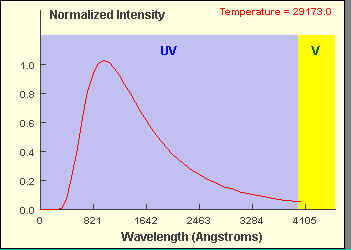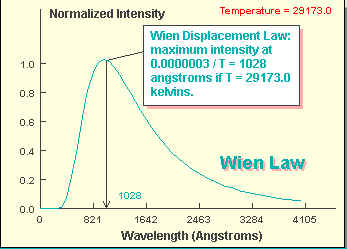Date: Mon Nov 15 12:35:13 2004
Posted By: Kenneth Beck, Senior Research Scientist, Chemistry and Physics of Complex Systems, Pacific Northwest National Laboratory
Area of science: Physics
ID: 1098724120.Ph
Message:
Dear Chris,
Interesting question. I looked back over previous MadSci responses to
your question and found one by Prof. Suzanne Willis (1999):
=> http://www
.madsci.org/posts/archives/sep99/936814333.Ph.r.html
Since its been 5 years, I think its appropriate to expand the answer she
gave back then.
First thing to consider is the temperature of a lightning bolt. A number
of source place this at 28,000-30,000 Kelvin, about 3 times the surface
temperature of the Sun…
=> http://hypertextb
ook.com/facts/1999/DavidFriedman.shtml
Using this, I have plotted the Planck’s Law for “black body” radiation at
~29,000K, then applied a Wien’s Law calculation for maximum intensity.
Here are those graphs (Graph Planck and Graph Wien):

 The first thing to note is that almost ALL of the light generated in a
lightning bolt is in the far ultraviolet and “invisible” region. Very
little is in the visible region. Wien’s Law indicates the maximum
intensity appears at 1028 Angstroms (102.8 nm). The energy of these
photons is enough to break apart oxygen and nitrogen molecules.
Subsequently this light would excite, ionize, and cause the emission of
their atomic and ionic species. Both oxygen and nitrogen atoms have part
of their fluorescence emission spectra in the visible region. All this
visible emission, taken as a whole, would appear a white or bluish-white
light to the human eye.
I have read that at a distance, lightning can have different shades of
color…
=> http://wvlightning.com/faqw10.html
I think this is mainly due to atmospheric effects of light refraction,
scatter by dust and other atmospheric molecules, etc. Similar to how the
Sun appears in different shades or hues of color at sunrise (the “green
flash”) and sunset…
=> http://hyperphysics.phy-
astr.gsu.edu/hbase/atmos/redsun.html
Hope this helps answer your question!
---* Dr. Ken Beck
The first thing to note is that almost ALL of the light generated in a
lightning bolt is in the far ultraviolet and “invisible” region. Very
little is in the visible region. Wien’s Law indicates the maximum
intensity appears at 1028 Angstroms (102.8 nm). The energy of these
photons is enough to break apart oxygen and nitrogen molecules.
Subsequently this light would excite, ionize, and cause the emission of
their atomic and ionic species. Both oxygen and nitrogen atoms have part
of their fluorescence emission spectra in the visible region. All this
visible emission, taken as a whole, would appear a white or bluish-white
light to the human eye.
I have read that at a distance, lightning can have different shades of
color…
=> http://wvlightning.com/faqw10.html
I think this is mainly due to atmospheric effects of light refraction,
scatter by dust and other atmospheric molecules, etc. Similar to how the
Sun appears in different shades or hues of color at sunrise (the “green
flash”) and sunset…
=> http://hyperphysics.phy-
astr.gsu.edu/hbase/atmos/redsun.html
Hope this helps answer your question!
---* Dr. Ken Beck
Current Queue |
Current Queue for Physics |
Physics archives
Try the links in the MadSci Library for more information on Physics.
MadSci Home | Information |
Search |
Random Knowledge Generator |
MadSci Archives |
Mad Library | MAD Labs |
MAD FAQs |
Ask a ? |
Join Us! |
Help Support MadSci
MadSci Network,
webadmin@madsci.org
© 1995-2003. All rights reserved.

 The first thing to note is that almost ALL of the light generated in a
lightning bolt is in the far ultraviolet and “invisible” region. Very
little is in the visible region. Wien’s Law indicates the maximum
intensity appears at 1028 Angstroms (102.8 nm). The energy of these
photons is enough to break apart oxygen and nitrogen molecules.
Subsequently this light would excite, ionize, and cause the emission of
their atomic and ionic species. Both oxygen and nitrogen atoms have part
of their fluorescence emission spectra in the visible region. All this
visible emission, taken as a whole, would appear a white or bluish-white
light to the human eye.
I have read that at a distance, lightning can have different shades of
color…
=> http://wvlightning.com/faqw10.html
I think this is mainly due to atmospheric effects of light refraction,
scatter by dust and other atmospheric molecules, etc. Similar to how the
Sun appears in different shades or hues of color at sunrise (the “green
flash”) and sunset…
=> http://hyperphysics.phy-
astr.gsu.edu/hbase/atmos/redsun.html
Hope this helps answer your question!
---* Dr. Ken Beck
The first thing to note is that almost ALL of the light generated in a
lightning bolt is in the far ultraviolet and “invisible” region. Very
little is in the visible region. Wien’s Law indicates the maximum
intensity appears at 1028 Angstroms (102.8 nm). The energy of these
photons is enough to break apart oxygen and nitrogen molecules.
Subsequently this light would excite, ionize, and cause the emission of
their atomic and ionic species. Both oxygen and nitrogen atoms have part
of their fluorescence emission spectra in the visible region. All this
visible emission, taken as a whole, would appear a white or bluish-white
light to the human eye.
I have read that at a distance, lightning can have different shades of
color…
=> http://wvlightning.com/faqw10.html
I think this is mainly due to atmospheric effects of light refraction,
scatter by dust and other atmospheric molecules, etc. Similar to how the
Sun appears in different shades or hues of color at sunrise (the “green
flash”) and sunset…
=> http://hyperphysics.phy-
astr.gsu.edu/hbase/atmos/redsun.html
Hope this helps answer your question!
---* Dr. Ken Beck